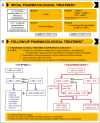Management of chronic obstructive pulmonary disease: A review focusing on exacerbations
- PMID: 31930287
- PMCID: PMC7005599
- DOI: 10.1093/ajhp/zxz306
Management of chronic obstructive pulmonary disease: A review focusing on exacerbations
Abstract
Purpose: Chronic obstructive pulmonary disease (COPD) is a significant cause of morbidity and mortality in the United States. Exacerbations- acute worsening of COPD symptoms-can be mild to severe in nature. Increased healthcare resource use is common among patients with frequent exacerbations, and exacerbations are a major cause of the high 30-day hospital readmission rates associated with COPD.
Summary: This review provides a concise overview of the literature regarding the impact of COPD exacerbations on both the patient and the healthcare system, the recommendations for pharmacologic management of COPD, and the strategies employed to improve patient care and reduce hospitalizations and readmissions. COPD exacerbations significantly impact patients' health-related quality of life and disease progression; healthcare costs associated with severe exacerbation-related hospitalization range from $7,000 to $39,200. Timely and appropriate maintenance pharmacotherapy, particularly dual bronchodilators for maximizing bronchodilation, can significantly reduce exacerbations in patients with COPD. Additionally, multidisciplinary disease-management programs include pulmonary rehabilitation, follow-up appointments, aftercare, inhaler training, and patient education that can reduce hospitalizations and readmissions for patients with COPD.
Conclusion: Maximizing bronchodilation by the appropriate use of maintenance therapy, together with multidisciplinary disease-management and patient education programs, offers opportunities to reduce exacerbations, hospitalizations, and readmissions for patients with COPD.
Keywords: chronic obstructive pulmonary disease; exacerbations; hospitalizations; patient care.
© American Society of Health-System Pharmacists 2020.
Figures


References
-
- Global Initiative for Chronic Obstructive Lung Disease. Global strategy for the diagnosis, management, and prevention of chronic obstructive pulmonary disease, 2019 report. https://goldcopd.org/wp-content/uploads/2018/11/GOLD-2019-v1.7-FINAL-14N... (accessed 2018 Dec 4).
-
- AbuDagga A, Sun SX, Tan H, Solem CT. Healthcare utilization and costs among chronic bronchitis patients treated with maintenance medications from a US managed care population. J Med Econ. 2013; 16:421-9. - PubMed
Publication types
MeSH terms
Substances
LinkOut - more resources
Full Text Sources
Other Literature Sources
Medical

